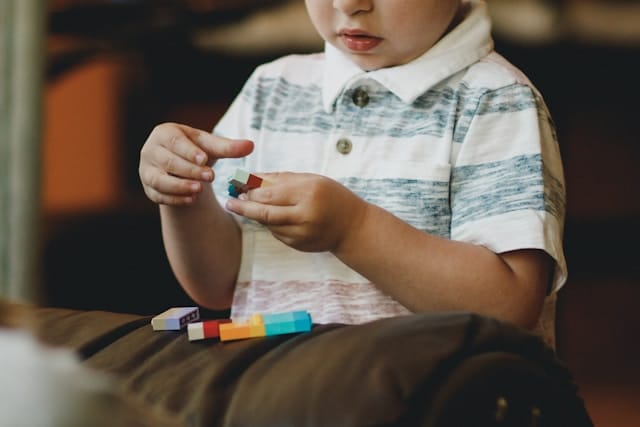The behavior of aligning objects is a common phenomenon observed in many people with autism spectrum disorder (ASD). This behavior, often seen in young children, raises many questions: Why do some individuals with autism consistently align objects, and what are the impacts of this behavior on their development, daily life, and social relationships? In this article, we will explore the underlying causes of this behavior and its various impacts on the lives of autistic individuals.
Table of Contents
1. What Is Object Alignment in Autistic People?
1.1 Definition of the Alignment Behavior
The behavior of object alignment, also called “aligning objects” or “arranging objects in an orderly fashion,” refers to the act of placing or arranging objects in a specific sequence or order. This action may involve toys, blocks, pencils, or even everyday items like cans, chairs, or coins. This behavior is commonly observed in children with autism, although in some cases, it may also appear in adults.
1.2 A Stereotyped and Repetitive Behavior
Aligning objects is part of the repetitive and stereotyped behaviors that are characteristic of autistic individuals. These types of behaviors are common in individuals with neurodevelopmental disorders. In the case of autism, these stereotyped behaviors may manifest in various forms: repetitive movements (such as rocking back and forth), body movements, or the alignment of objects.
1.3 Differences from Other Children’s Behaviors
While object alignment may also be observed in neurotypical children, the frequency and intensity of this behavior in autistic people are much more pronounced. This behavior can become overwhelming, interfering with free play, exploration, or social interactions, which are essential aspects of a child’s development. For autistic individuals, aligning objects can become an obsession, limiting their adaptability in social and school environments.
2. Causes of Object Alignment in Autistic People
2.1 The Need for Sensory Regulation
One of the primary factors explaining why many autistic individuals align objects is the need for sensory regulation. Autistic individuals often experience hypersensitivity to sensory stimuli, such as sounds, lights, textures, or smells. These stimuli can be overwhelming and lead to anxiety. Aligning objects becomes a self-soothing strategy, a way for the individual to create a calmer, more predictable environment.
Research indicates that object alignment may play a crucial role in regulating the sensory system. For autistic individuals, this act can offer an immediate response to manage intense emotions and unpleasant sensations from the environment.
2.2 The Search for Predictability and Control
Another key reason for object alignment in autistic individuals is the need for predictability. Autistic individuals often struggle with the unpredictability of their environment, which can lead to stress and anxiety. By aligning objects in an orderly and structured way, they create an environment they can control, thus providing a sense of security and stability.
The need for predictability and control is a common feature of autism, and this repetitive behavior offers a form of comfort in the face of uncertainty and the constant changes in the external world.
2.3 The Role of Systematization in Autism
Researcher Simon Baron-Cohen, known for his work on autism, introduced the concept of systematization in his studies. According to him, autistic individuals have a natural inclination to organize and systematize their environment. Object alignment can thus be seen as a manifestation of this tendency to organize elements of the world according to patterns, structures, or sequences.
For autistic individuals, this tendency to look for patterns in objects, to arrange them in an orderly way, and to search for relationships between these objects is a defining characteristic. Object alignment, therefore, becomes a form of systematizing the world, allowing them to feel more secure and competent.

Child with autism aligning objects
3. Impacts of Object Alignment on Autistic People
3.1 Impact on Cognitive and Social Development
Object alignment can have a significant impact on the cognitive and social development of autistic individuals. On the one hand, it can interfere with the development of social skills, as it may limit interactions with other children or adults. Children who spend a lot of time aligning objects may be perceived as having difficulty connecting with their peers or participating in group play.
On the other hand, while object alignment may limit certain forms of social learning, it can also stimulate cognitive abilities such as attention to detail, memory, and the ability to organize information. However, it is important that this behavior is monitored and does not become an obstacle to the development of social and communication skills.
3.2 The Role of Object Alignment in Self-Soothing
The primary role of object alignment in many autistic individuals is as a self-soothing mechanism. This repetitive behavior helps reduce anxiety by providing immediate distraction and creating a sense of calm in an environment that is often perceived as chaotic. Object alignment, therefore, can be seen as an adaptive response to sensory overstimulation, allowing the individual to center themselves and regain calm.
This phenomenon can have benefits, as it helps autistic individuals manage their stress and cope with emotionally challenging situations. However, if object alignment becomes excessive, it can restrict opportunities to explore other forms of emotional regulation and limit flexibility in managing emotions.
3.3 Effects on Quality of Life
If object alignment becomes overwhelming, it can negatively impact an autistic person’s quality of life. For example, a child who spends a significant amount of time aligning objects may be less engaged in learning or exploration activities, potentially slowing overall development. Additionally, in social environments like school, object alignment may lead to the child being marginalized, making them less interactive and isolated from other children.
It is therefore crucial to monitor this behavior and implement strategies that help the individual maintain a balance between self-soothing and social and educational interactions.
4. Support and Intervention Strategies
4.1 Behavioral and Sensory Integration Therapies
Behavioral therapies, such as Applied Behavioral Analysis (ABA), are commonly used to address repetitive behaviors, including object alignment. These interventions are often personalized to help the individual understand and modify non-functional behaviors while promoting the development of social, communication, and self-help skills.
Additionally, sensory integration therapies are a helpful approach to treating sensory hypersensitivity in autistic individuals. These therapies aim to help individuals better manage sensory stimuli by creating more suitable environments, thereby reducing the need for object alignment as a form of regulation.
4.2 Encouraging Creative Alternatives
It is also important to encourage autistic individuals to explore creative alternatives to repetitive behaviors like object alignment. Structured activities that stimulate creativity and social interaction can offer solutions to occupy time in a more flexible way. Artistic activities, role-playing games, or learning new skills can promote a balance between self-soothing and engagement with others.
4.3 The Importance of Family and Educational Support
Families, educators, and therapists play a vital role in managing this behavior. Ongoing support allows autistic individuals to develop more adaptive strategies for coping with their sensory, emotional, and social challenges. Effective collaboration between parents, educators, and health professionals is essential for developing personalized intervention plans that promote the individual’s well-being and overall development.

5. Research Perspectives and Evolving Understanding of Autism
5.1 Systematization: A Pathway to Understanding Autism
Research by scientists like Simon Baron-Cohen has contributed to a better understanding of stereotyped behaviors like object alignment. By studying systematization in autism, these researchers have highlighted the importance of cognitive mechanisms involved in organizing and managing information.
5.2 Recent Studies on Repetitive Behaviors
Many recent studies on repetitive behaviors in autism reveal that these behaviors are not just expressions of stress or frustration. They may also serve as adaptive mechanisms, helping autistic individuals structure their environment and navigate a world that is often perceived as disordered.
5.3 Towards a More Inclusive and Flexible Approach
Advances in the understanding of autism are leading toward a more inclusive and flexible approach. The goal is to value the unique strengths of autistic individuals, such as their ability to organize and structure their environment, while providing them with tools to better manage object alignment and other repetitive behaviors.
Conclusion: Advice for Parents
For parents, the key advice is to approach this phenomenon with patience and understanding. It is crucial to recognize that each autistic child is unique, and object alignment may be a natural response to specific sensory or emotional needs. By being attentive to signs of anxiety or stress associated with this behavior, parents can play a key role in offering appropriate support.
One of the best ways to support a child exhibiting this behavior is to offer creative and functional alternatives to address their sensory and emotional needs. Encourage games that promote communication and collaboration while also providing moments for the child to self-soothe in healthy ways. Additionally, working with professionals, such as behavioral therapists or sensory integration specialists, can help create personalized strategies that are tailored to the child’s needs.
Ultimately, remember that object alignment is not necessarily an obstacle to your child’s development. On the contrary, it can be an opportunity to better understand their needs and provide them with a structured yet flexible environment. By adopting a gentle and respectful approach, parents can help their autistic children thrive while developing new skills for interacting with the world.
The orderly manipulation of small objects is considered a stage in the development of the autistic structure, and we must support them as they progress toward a higher stage
You can also read our post: What Is The Reasons Behind Repetitive Movements In Autistic Individuals?

Pingback: What is the Reasons Behind Repetitive Movements in Autistic Individuals
Pingback: Autism and Object-Holding: 5 Key Reasons Behind This Common Behavior
Pingback: What is the Reasons Behind Autistic Repetitive Movements